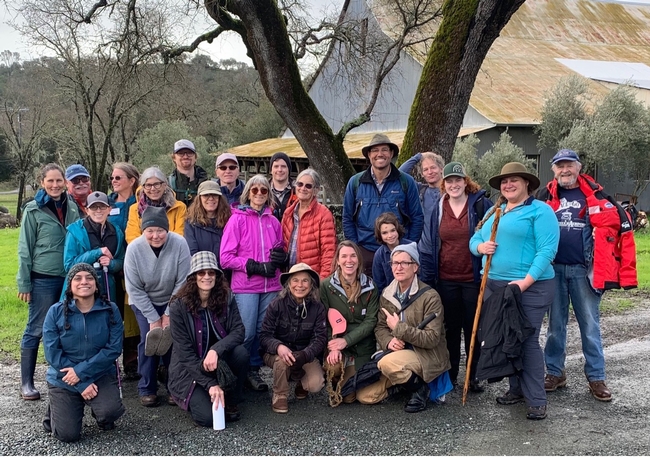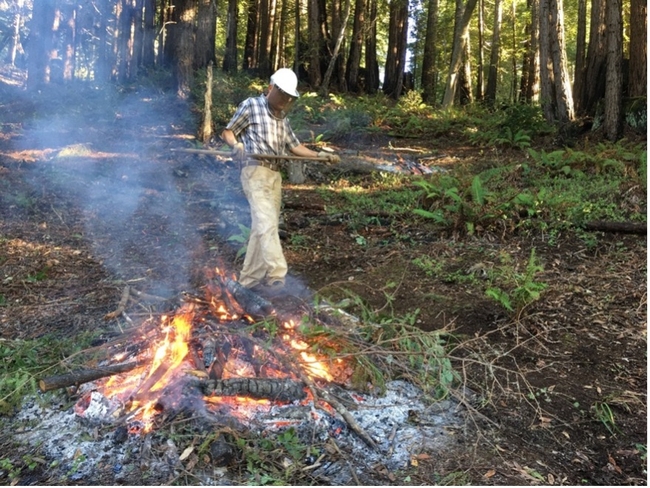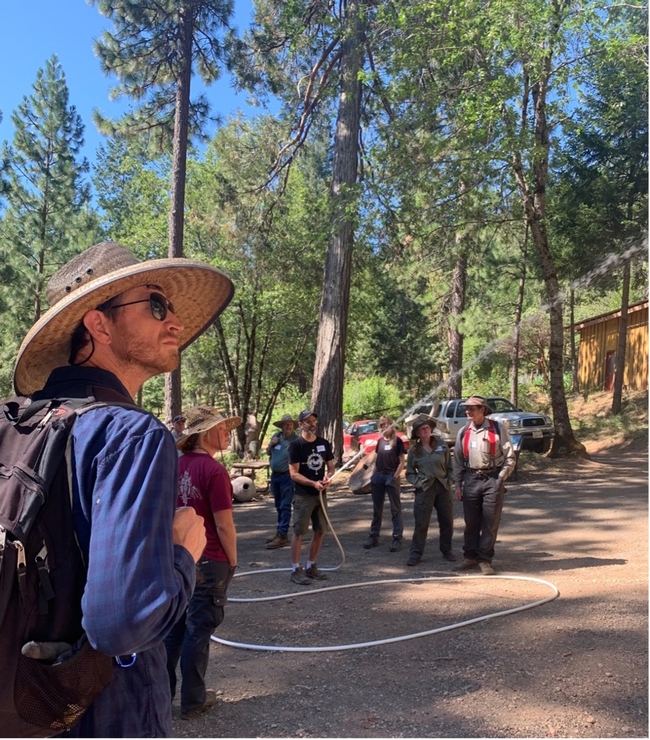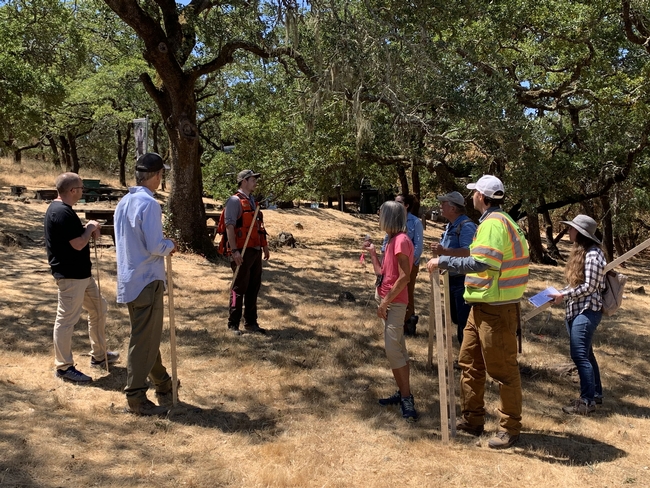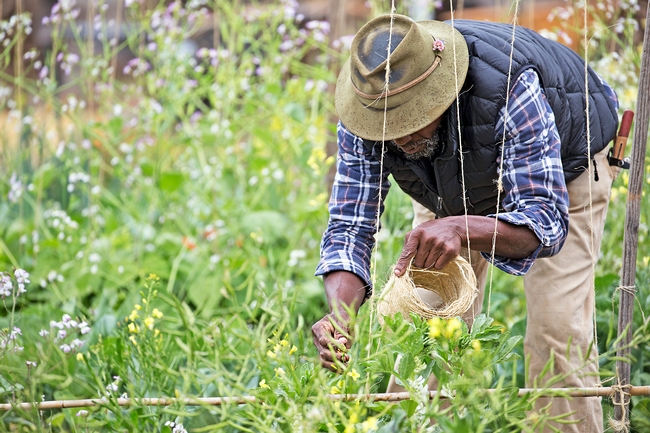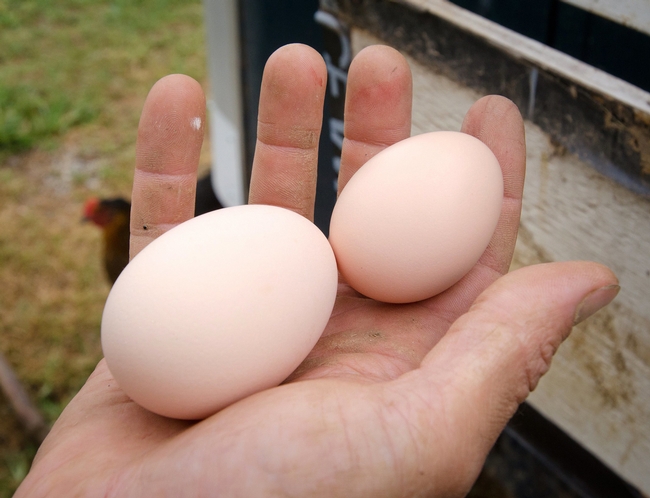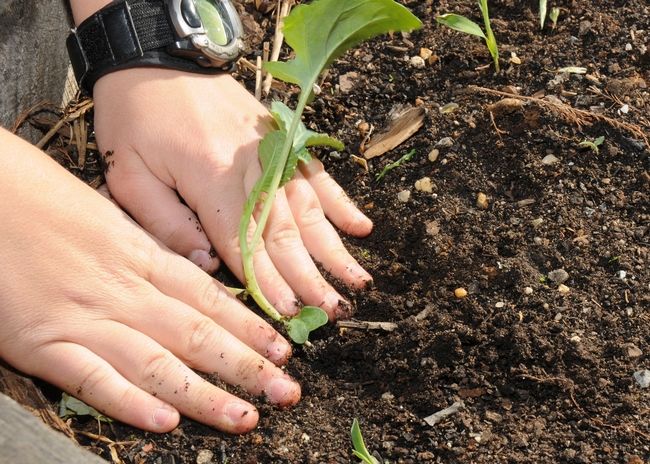Posts Tagged: Kim
Forest research and outreach compiles forestry voices in new story map project
For the past four years, Kim Ingram has been listening closely to the private forest landowners who participate in her Forest Stewardship Workshop series. During the workshops, landowners share their experiences clearing thickets of vegetation, replanting post-wildfire and tackling invasive species, and their concerns of who will take care of their forest when they're gone.
To alleviate their stress, Ingram–Forest Stewardship Education coordinator with University of California Agriculture and Natural Resources–turns to natural resource professionals from CAL FIRE, local Resource Conservation Districts, and the U.S Forest Service who can share knowledge and resources with participants. Recently, Ingram developed a story map that aims to provide landowners with a platform they can use to share their experiences and ways that they have been empowered to manage their land.
"It's not uncommon for small forest landowners to feel overwhelmed with their forest management responsibilities and uncertain over what steps to take first," said Ingram. "Through the Forest Stewardship Workshops and this story map project, we hope to show that there is an entire community of forest landowners in the same situation, learning from each other and moving forward towards their management goals."
The Forest Stewardship Story Map team used ArcGIS StoryMaps to design the project, with 15 participants providing interviews and visual content. StoryMaps provides a user-friendly interface where website visitors can either click on a county to view specific interviews or scroll to view the stories.
The forestry team plans to interview at least one landowner and natural resource professional in every forested county in California so private forest landowners have a local contact or can become inspired by a project in their area.
Theresa Ciafardoni, a forest landowner in Nevada County, said that the UC ANR Forest Stewardship Workshop helped her manage postfire restoration and long-term land use planning.
"It opened up so many options and possibilities," said Ciafardoni. "All the individuals who presented in the Forest Stewardship Workshop were open to phone calls for specific questions and provided invaluable technical assistance."
Involving landowners and forestry professionals with this project was an early decision made by Ingram, who believed it was important that the map held appeal beyond hosting stories. Now, the project functions as a networking tool for landowners seeking professional assistance, too.
Past Forest Stewardship Workshop presenters shared their contact information and the motivations behind their forest management work so that landowners could find assistance in their area. The professionals currently hosted on the map include Resource Conservation District managers, UC ANR forestry advisors and private contractors.
"The most motivated landowners are invested not only economically, but their heart is into it," said Ryan Tompkins, UC Cooperative Extension forestry advisor for Plumas, Sierra and Lassen counties. "The natural world is full of uncertainty, but they're committed to continuing education and learning about how to be a good land steward. This takes a certain level of humility recognizing that our tenure as a steward on the land is a very short period of a forest's lifetime."
Looking ahead, the team envisions the map as a working document that will eventually include interviews with indigenous tribal members who focus on traditional ecological knowledge projects, interviews and information from the UC ANR Postfire Forest Resilience Program, and a feature that will filter stories by topic (e.g. reforestation or prescribed burning).
"This isn't a project that could be completed by one person," explained Grace Dean, Forest Stewardship communications specialist. "The same way that Kim and other presenters explain forest management as a collaborative process holds true for this project."
The Forest Stewardship Workshop series gives participants the ability to start as beginners and build upon their knowledge and experiences. In the same vein, this story map provides the Forest Stewardship team a solid base of real stories to add on to over time. The hope is that it will grow into a multifaceted tool reaching new forest landowners, eventually enveloping their stories within the small forest landowner community.
To view the Forest Stewardship Story Map, visit: https://storymaps.arcgis.com/stories/bd062108d9894da7920d7aef06fe2c2c.
Workshops for forest landowners come to Solano, Sacramento counties, beginning July 18
Free forester site visit for landowners who complete workshop series
Forest landowners in Solano and Sacramento counties are encouraged to learn about their forests and connect with natural resource professionals in their areas during the next Forest Stewardship Workshop Series from University of California Cooperative Extension, July 18 to Sept. 12. These programs can be essential for small landowners who seek to make their forests resilient against wildfire.
Upon completing the nine-week series of virtual and in-person sessions, landowners also will be eligible for a free site visit from a local Registered Professional Forester (RPF), Certified Range Manager or California Certified Burn Boss.
Content is applicable to all forest landowners regardless of where their forest is located and will highlight talks from the local Resource Conservation District, UCCE forestry advisors, CAL FIRE, Natural Resources Conservation Service, and other natural resources community leaders. Registration fee is $60 for the workshop series, which will address common concerns among California landowners, including but not limited to:
- Forest ecology and vegetation management
- Financial planning and cost-sharing opportunities
- Oak woodland management and targeted grazing
Past participants have rated the workshop series highly, with 98% of 2022 participants rating the series overall as excellent or very good. In addition, 94% of past participants reported greater awareness of applying for and using cost-sharing programs.
A past participant has described the workshops as very accessible, saying “they (UCCE) broke things down into small pieces, [and] staff were always an email away.” In seeking to make an otherwise large amount of content approachable, UCCE hopes that landowners come away with a holistic understanding of the management process.
The workshop will take place in a hybrid setting, with classes taking place weekly online over Zoom. Participants will also engage in practical learning through a field day, where they can meet other cohort members and UCCE professionals at an outdoor field location.
At the conclusion of the workshop series, landowners will be equipped with the knowledge and network that will empower them to manage their forests in ways that meet their specific goals and objectives.
Community members in Sacramento and Solano counties interested in forest management, forest and fire ecology, and related topics are encouraged to register: https://surveys.ucanr.edu/survey.cfm?surveynumber=28675.
Forest landowners across California can learn about upcoming workshops in their areas, and also find additional resources, publications and videos: https://ucanr.edu/sites/forestry/Stewardship/.
The Buzz Behind the UC Davis Bumble Bee Contest
The Bohart Museum of Entomology generated a lot of buzz when it sponsored its second annual "Robbin Thorp Memorial First-Bumble-Bee-of-the-Year...
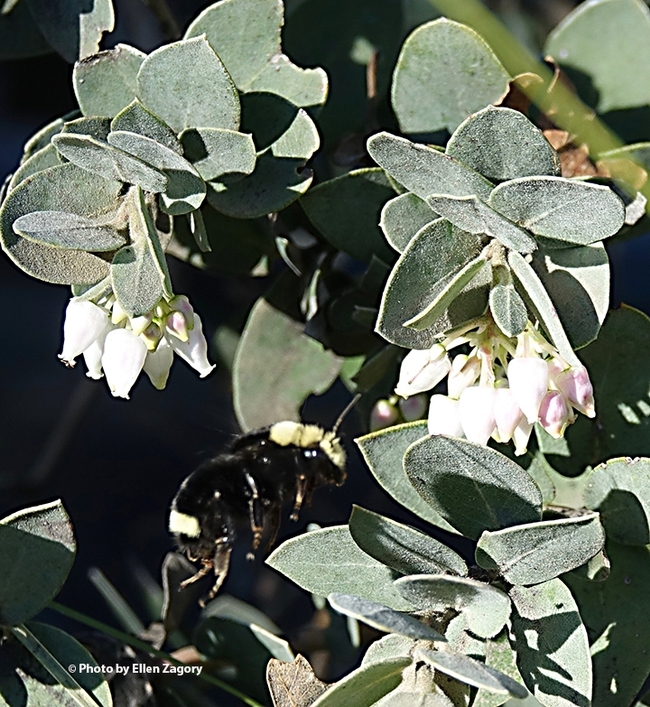
This is the image of Bombus vosnesenskii that Ellen Zagory captured in the UC Davis Arboretum and Public Garden.
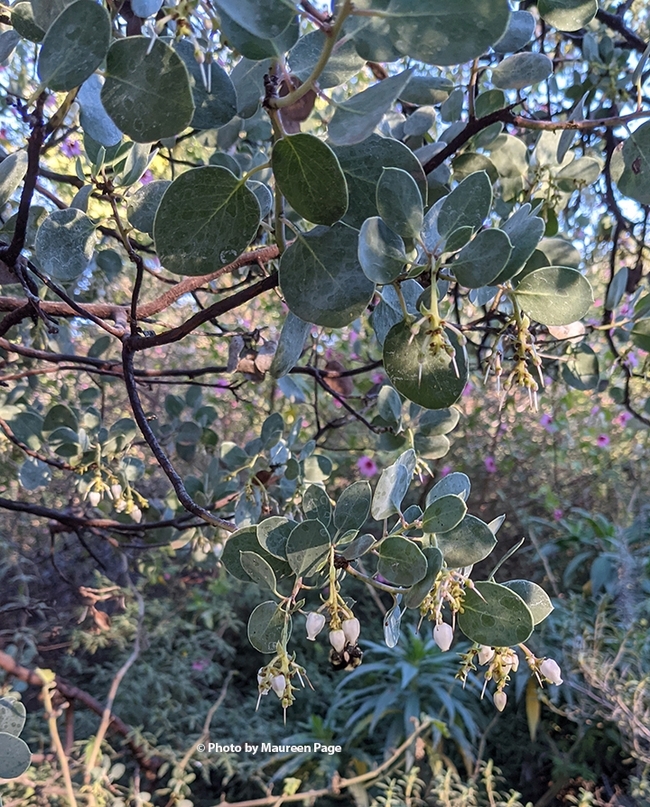
This is the cell phone image of Bombus melanopygus that Maureen Page took in the UC Davis Arboretum and Public Garden.
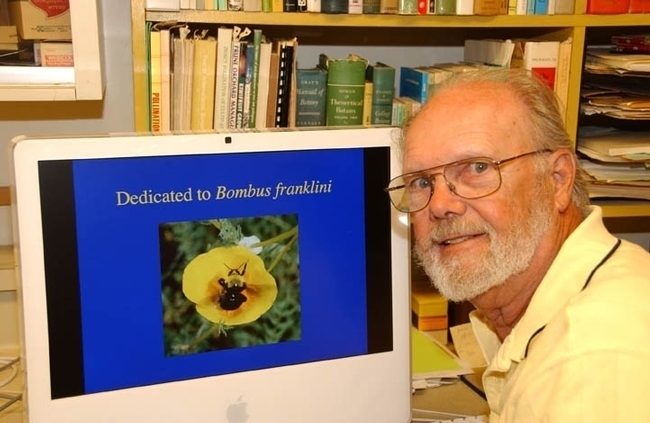
The late UC Davis professor, Robbin Thorp, shown here with an image he took of the endangered Franklin's bumble bee, always looked forward to finding the first bumble bee of the year.
Honey Bee Geneticist Rob Page and His 30-Years of Research: Getting From There From Here
If you're a honey bee geneticist and you're asked to highlight your three-decade scientific career, how do you start? Societies to genes? And how do...
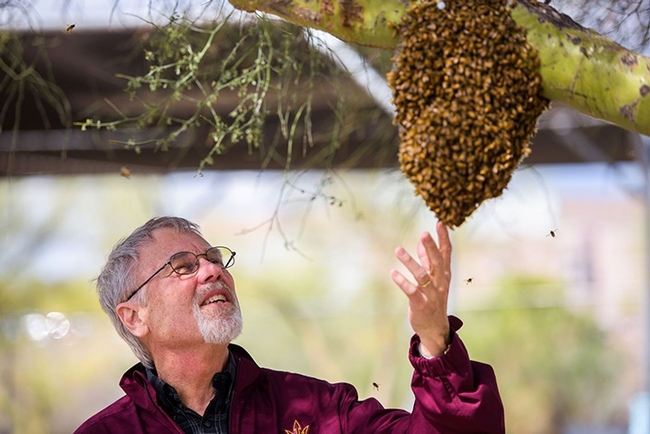
Honey bee geneticist Robert E. Page Jr. examines a swarm.
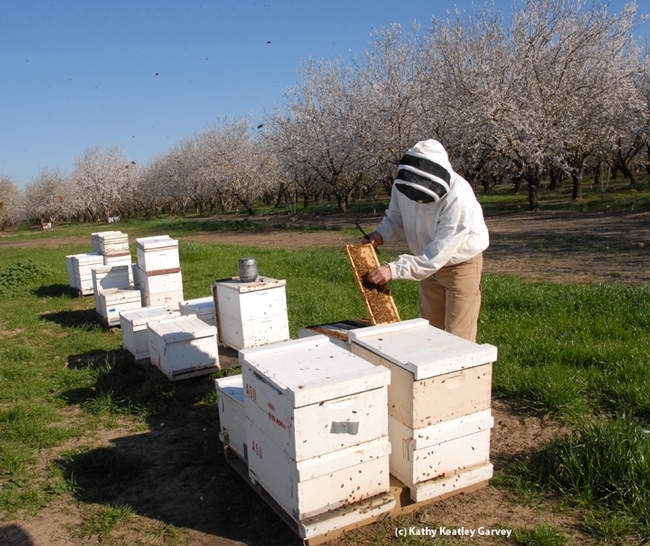
Robert E. Page Jr., maintained a UC Davis honey bee-breeding program, managed by Kim Fondrk, at the Harry H. Laidlaw Jr. Honey Bee Research Facility for 24 years. Here Fondrk checks on the UC Davis bees in a Dixon almond orchard. (Archived photo by Kathy Keatley Garvey)
Smoke and ash from wildfire may have lingering impacts in food production
A summer of smoke and ash in many parts of California has raised questions about the safety of produce growing on farms and in the garden, eggs laid by chickens who peck around in ash-laden areas, and remediation needed to safely and effectively grow food in the future.
UC Agriculture and Natural Resources brought together experts who have researched the effects of previous fires' fallout and studied soil contaminants to share their insight in a two-hour webinar now available on YouTube.
“The No. 1 health concern during a fire is smoke inhalation, and it's been well documented that wildfire smoke can negatively impact both the heart and the lungs,” said Claire O'Brien, a pharmacology and toxicology doctoral student at UC Davis. “However, the chemicals found in the smoke don't just stay in the air. They can deposit onto plants and into soil and water.”
Although every fire is unique, some generalizations can be drawn from research conducted following previous fires. UC Cooperative Extension food systems advisor Julia Van Soelen Kim detailed a study conducted following the October 2017 wildfires in Sonoma County and across the North Bay.
With the help of UC Master Gardener and community volunteers, the researchers collected over 200 samples of homegrown collard greens, lettuces, kale and chard that were exposed to wildfire smoke and ash. A subset of the samples were analyzed by a private laboratory.
“There was very low concern about chemicals on produce,” Van Soelen Kim said. “No samples had detectable levels of lead, arsenic, mercury or chromium. And that's a huge sigh of relief.” However, analytical results vary by site, site history and by fire event, and few have pre-fire baseline data to compare with.
Van Soelen Kim said basic food-safety practices should be followed when preparing to eat food grown in a home garden, regardless of ash or smoke contamination.
“You should always wash your hands before and after harvesting, and wash your produce in running water to mitigate any kind of potential risk,” she said.
Are backyard chicken eggs safe to eat?
Another study outlined at the webinar used a similar process to determine whether there might be contaminants in the eggs laid by backyard poultry that live and feed in areas exposed to wildfire ash and smoke.
Scientists know from previous research that chickens exposed to lead in their environment can produce eggs with high lead content and that heavy metal content of ash from urban wildfires is higher than from rural wildfire.
“We combined those two pieces of research with what we know that chickens do all day: they peck at the ground for hours on end,” said Todd Kelman, a veterinarian in the School of Veterinary Medicine at UC Davis. “That makes for a pretty good hypothesis that urban wildfire could pose a risk for the production of eggs and poultry that contain heavy metals.”
Kelman and his team put out a call for eggs from backyard poultry and received samples from 344 premises in fire-affected and non-fire-affected areas of California.
Surprisingly, egg samples that contained higher lead levels came from parts of the state that were not directly impacted by ash and smoke.
“Did our data support our hypothesis that proximity to urban wildfire is a driving source for lead in eggs of backyard poultry? The answer is not so much,” Kelman said. “So, is it safe to eat eggs from your backyard poultry? We can't give you a definitive answer to that question. But we do suggest you assess your risk and reduce the risk of contamination.”
Practices that reduce the risk include keeping chickens off the ground, using a chicken feeder that prevents spillage onto the ground and making calcium readily available, for example in the form of oyster shells, because calcium can prevent the absorption of lead. Making sure that chickens are provided uncontaminated water is also an important part of risk reduction.
For confirmation on the safety backyard chickens and their eggs, lab tests for eggs are available for $60 from the California Animal Health and Food Safety Laboratory at UC Davis, or chickens may be submitted to CAHFS for necropsy.
Are soils safe for growing food after a fire?
Fire effects on soil is another consideration in burned areas, said UC Cooperative Extension urban agriculture advisor Rob Bennaton.
“Fires heat topsoil layers. They reduce the amount of living micro-organisms at the site of the burn, and also affect organic matter and nutrients. Ash deposits over time may make soils more alkaline,” he said. “As a result of these combined factors, there are temporary changes in nutrient levels and the capacity for soils to exchange nutrients for optimal plant growth and nutrition.”
With proper land care and management, soils can be remediated over time.
“It won't happen overnight. Soils were developed over millions of years,” he said.
Some ways to improve safety when gardening in fire-affected areas including keeping the soil covered with wood chips or other landscape mulch to reduce airborne soil dust. Use drip irrigation to prevent up splash onto the undersides of growing vegetables. Promote good drainage, especially at the bottom of slopes to prevent the concentration of contaminants.
Lab tests are often needed to determine the soils' post-fire characteristics. “Don't guess, but test,” Bennaton said.
The UC Master Gardener Program can provide technical assistance to help home gardeners find resources for home soil testing, he said.
Additional resources and information shared during the webinar include:
Post-fire soil resources and soil testing information
- UCCE publication on Soils in Urban Agriculture with soil testing & sampling information
- The UC ANR Healthy Soils Website, which has many resources worth reviewing.
- Tips for Interpreting Soil Analysis
- UC Master Gardener of Sonoma County 2018 workshop video “Effects of fire on soil”
Post-fire food safety
- Research on produce safety and backyard chicken egg safety after the 2017 wildfires in California is available on this web page. To view a past webinar recording with these research findings, click this link.
- Poultry wildfire resources from the UC Davis School of Veterinary Medicine:
- Best Practices for Produce Safety After Fire
- Understanding Risk: A community guide for assessing the potential health impacts of locally grown produce exposed to urban wildfire smoke
Firewise and sustainable home landscaping design in the defensible space zone
- Visit the UC Master Gardener Program of Sonoma County firewise landscaping web page.
- For a recent firewise & sustainable design and maintenance video by the Resilient Landscapes Coalition.
Impact of smoke & ash on plants
[This article was first published Nov. 3, 2020]


